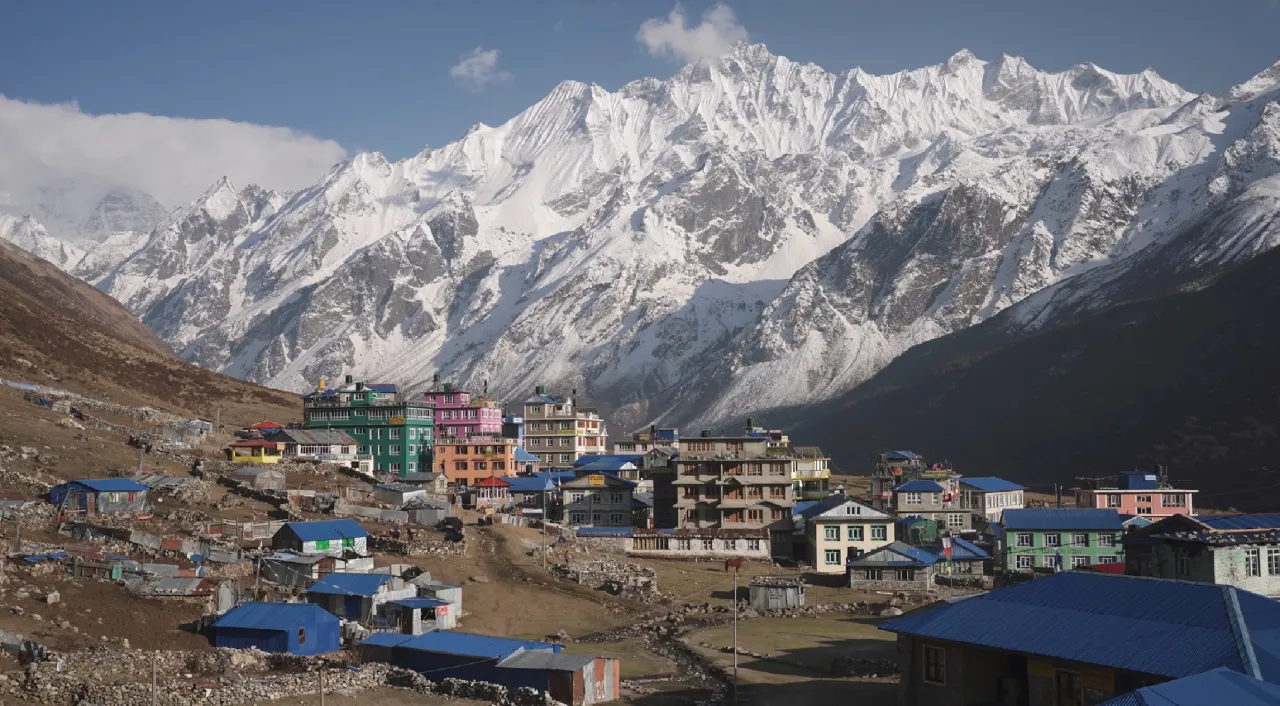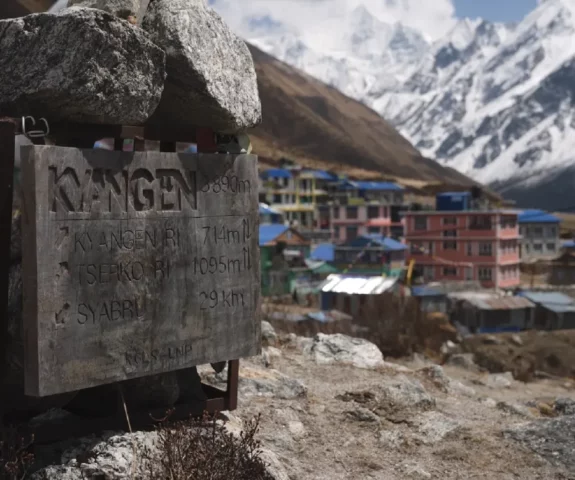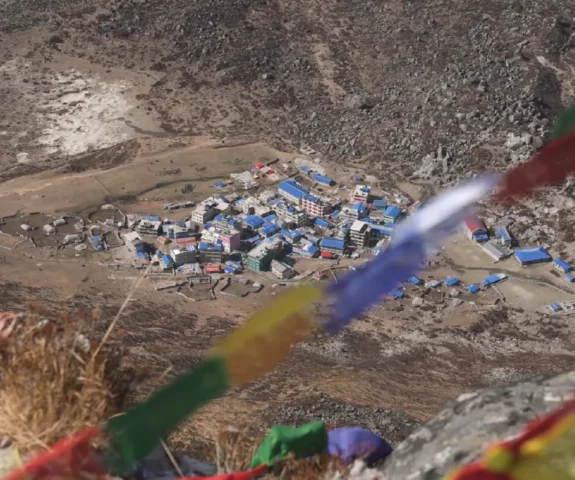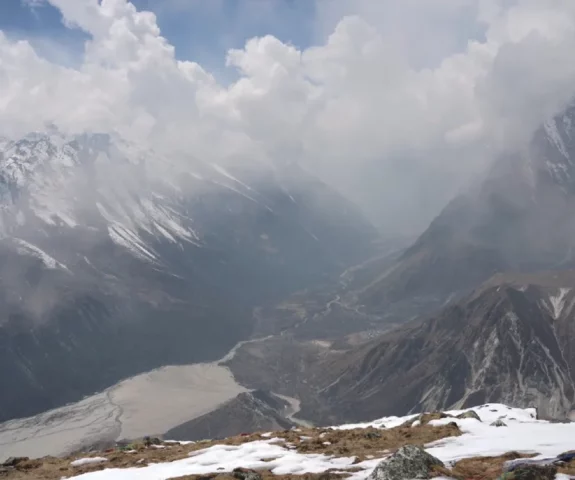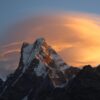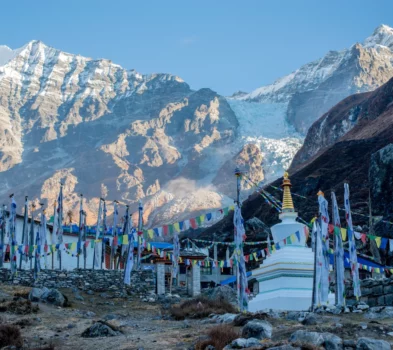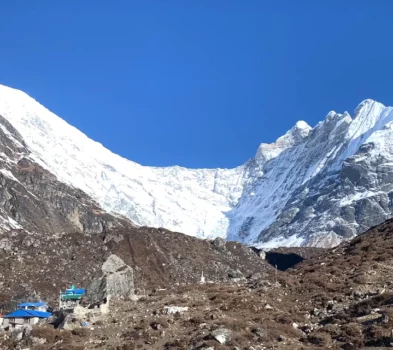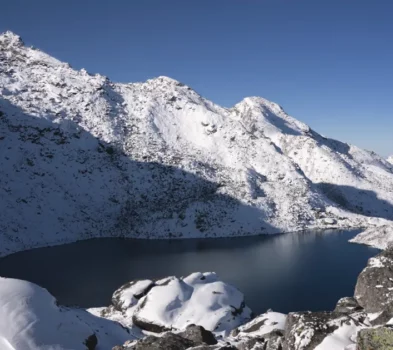Duration
10 DaysLangtang Valley Trek
Trip Grade
ModerateGroup Size
1 -16 PeopleMax Altitude
4,773m. / 15,659ft.Best Season
Feb- May/ Sept- NovActivity
Trekking and HikingMeals
Breakfast, Lunch & DinnerAccommodation
Hotels & TeahousesTransportation
Private Vehicle & BusTrip Customization
On request (click here)Highlights of Langtang Valley Trek
- An enthralling road trip to Rasuwa District near the Chinese Border
- A romantic walking journey through the enchanting villages of the Tamangs and Sherpas where every corner reveals a new charm
- Meet the elusive and stunning wildlife of Langtang National Park, including the rare red panda, langurs, Himalayan tahr, and snow leopard
- Step inside the sacred land of Kyanjin Gumba, a place with spiritual significance and breathtaking views
- Triumphantly ascend the breathtaking height of 4773 m Kyanjin Ri
- Forget yourself in the magical landscape of the Langtang Lirung glacier, Tsergo Peak, Naya Kang, Changu, Langshisa Ri, Ganchenpo, Yurba, Yala Peak, Langtang II, Kimshung, and Dorje Lhakpa
- A family-friendly brief journey with minimal risk of acute mountain sickness ensuring a safe adventure for all ages
Trip Introduction
A very simple but very beautiful and special route is the Langtang Valley Trek that is hidden in the northeastern part of Nepal. With a gentle path and a delightful surprise at the end, the Langtang Valley trekking itinerary can be completed by almost anyone, in any season.
With the almost entirely walking route, our Langtang Valley trek 10-day journey will take you through the enchanted realms of the Langtang Valley located in the Langtang Region, around 30 km away from Kathmandu valley.
Embraced by the powerful Jugal (6095 m) and Langtang Lirung (7234 m) peaks, this Valley lies as a remarkable part of the national park of Langtang.
This protected landscape is enriched with life, which features more than 1000 species of plants, including varied rhododendrons, bamboo, and sky-touching conifers.
It also serves as a safeguarding shelter to 150 varieties of birds, and many wildlife including red pandas, wild sheep, Himalayan tars, bears, tigers, and secretive snow leopards, creating a dynamic ecosystem.
Our Langtang Valley trek commences with the enthralling road journey to Syabrubesi from Kathmandu. Nestled in the Rasuwa District close to the Tibetan border, this charming village is where your journey truly begins. As you set off, the path will take you through the delicately beautiful hamlets of Sherpa and Tamang inhabitants.
They are the special people, very unusual, who have become the landmarks of this trek. Their cordiality, hospitality, and talkativeness will really shock you in the first days. But you will get used to the good and kind quickly, and by the end of the trip, it will be completely unclear how you lived without all this before.
We promise you that by the end of the Langtang Valley trek, you will return home with a piece of Tamang and Sherpa soul, which will probably be the most vivid impression of the trip.
Then, our Langtang Valley trekking itinerary will take you to the pious land of Kyanjin Gumba elevated at almost 4000 m altitude. Boasting the colorful and architectural masterpiece of Kyanjin Monastery, this small final settlement of the Langtang Valley is the beautiful playground of the Kimshung (6781 m), Langtang Lirung, Dorje Lhakpa (6966 m), Gangchempo (6387 m), Chorakri Ri (5050 m), Langshisha Ri (6427 m), and Kyanjin Ri (4773 m) ranges.
The surprise of this trek is your triumphant climb over the 4773 m high Kyanjin Ri, where you can see the sunrise casting its magical glow over the massive Langtang Lirung glacier, Tsergo Peak (5033 m), Naya Kang (5846 m), Chang (6750 m), Langshisa Ri, Gangchempo, Yurba (6035 m), Yala Peak (5500 m), Langtang II (6586 m), Kimshung, and Dorje Lhakpa.
After getting used to the grandeur of the Himalayas and its highlands, it’s time to return to the lively atmosphere of Kathmandu, following the same circular route you took at the beginning of your Langtang Valley trek adventure.
Overall, in ten days of your travel, you will have active recreation, some quality rest, and a collection of a variety of impressions in a friendly company. So don’t delay your journey for long and don’t let this chance slip away! Book your place now and go on an adventure to one of nature’s most beautiful creations up close.
Outline Itinerary of Langtang Valley Trek
Day 01: Arrival at Kathmandu Airport.
Day 02: Drive from Kathmandu to Syabrubesi (1503 m).
Day 03: Trek from Syabrubesi to Lama Hotel (2500 m).
Day 04: Trek from Lama Hotel to Langtang Valley (3430 m).
Day 05: Trek from Langtang Valley to Kyanjin gumba ( 3835 m).
Day 06: Explore day in Kyanjin Gumba and hike to Kyanjin Ri (4773 m).
Day 07: Trek from Kaynjin Gumba to Lama Hotel (2500 m).
Day 08: Trek from Lama Hotel to Syabrubesi (1503 m).
Day 09: Drive from Syabrubesi to Kathmandu.
Day 10: Departure to Kathmandu Airport.
Our guests sharing their experiences (Photo/Video Gallery)
Detail itinerary of Langtang Valley Trek
Day 01: Arrival at Kathmandu Airport.
The capital of the Kingdom of Skies is delighted in the grace of your presence. Our Himalayan Adventure representative will be ready to greet you at the entrance of TIA with welcoming scarves (Khada).
Then, you will be transferred to your overnight lodging in Kathmandu. Make sure to rest and if you happen to arrive early, take this chance to wander through the picturesque narrow streets of the capital.
In the evening, after all the participating guests of the Langtang Valley trek arrive, there will be a meet and greet program with our tour guide who will then give you an introductory briefing about the Langtang Valley trekking itinerary.
Later, enjoy the first taste of Nepalese cuisine: its aroma of spices, juicy vegetables, and unusual presentation of dishes.
Activity: Airport Pickup, 30min
Max. Altitude: 1,400m/4,593ft. Kathmandu
Accommodation: Hotel
Day 02: Drive from Kathmandu to Syabrubesi (1503 m).
Today you have an exciting road journey that will take you towards the northern part of Nepal, to the amazing settlement of Syabrubesi positioned in the Rasuwa district of Nepal near the Tibetan border.
Our journey begins as we board the bus and make our way out of Kathmandu through Kalanki and Thankot. From here, the Trishuli Highway will take us to the colorful market of Trishuli, where we will take a moment to refresh ourselves.
Then, we will continue our journey along the long Pasang Lhamu Highway, which gently ascends alongside the jagged cliffs. As we climb higher, the stunning snowy peaks of Ganesh, Manaslu, and Annapurna will reveal themselves, standing majestically above the landscape.
We will soon reach Rani Pauwa and cross Dhunche, where an army checkpoint will check our documents hinting we are now entering the protected territory of the National Park of Langtang.
In the distance, Langtang Himal will bestow its magical smile upon us as we follow the never-ending twisting road that will lead us toward our destination, Syabrubesi.
Activity: Drive, 6-7 hours
Max. Altitude: 1,503m/4,931ft. Syabrubesi
Meal: Breakfast, Lunch & Dinner
Accommodation: Teahouse
Day 03: Trek from Syabrubesi to Lama Hotel (2500 m).
It is now time for us to get on with our trekking adventure. After leaving Syabrubesi, we will hike for a while and meet the so well-known suspension bridges of Nepal.
One after another, we will cross two of these remarkable bridges that arch over the stunning Bhote Koshi River. Then, the gentle flow of the Langtang River will lead us to the charming Dhomen Hamlet (1620 m).
As we continue, the trail will gradually rise through a lush jungle filled with conifers and rhododendrons until we reach Bamboo (1970 m). A brief rest here with the majestic Langtang Himal in view will prepare us for the challenging climbing of the steep steps of large stones that will demand two hours of effort.
After overcoming this challenge, we will arrive at Rimche Village (2400 m). The path ahead becomes less steep as we travel through the dense thickets of rhododendrons. In about two hours, we will be resting in one of the cozy lodges at Lama Hotel.
It is the key resting point for all trekkers on the Langtang Valley trek or Gosaikunda. Keep your eyes peeled at the window; you may just be lucky enough to catch a glimpse of the elusive red panda of Langtang.
Activity: Trek, 6-7 hours
Max. Altitude: 2,500m/8,202ft. Lama Hotel
Meal: Breakfast, Lunch & Dinner
Accommodation: Teahouse
Day 04: Trek from Lama Hotel to Langtang Valley (3430 m).
The Langtang Khola will remain our loyal guide who starts to once more lead us through the deep, shadowy forests of Langtang National Park. After we reach Ghumanchok, we will encounter yet another army checkpoint, where our permits and documents will be carefully checked.
From this point, the journey continues upward as we ascend toward Chunama. But the striking sight of Langtang Lirung will keep capturing our gaze so our journey will be relatively comfortable and short.
Battling the steep inclines, we will finally reach 2800 m high Ghoratabela translated as Horse Stable. The trail now winds down towards Thangshyap, Ghumba, and Chyamki. Eventually, we will step into the land of the revitalized valley of Langtang which still showcases the remnants of the 2015 earthquake along with the remarkable transformation since then.
The timeless beauty of Ganesh, Naya Kanga, Langtang Lirung, and Dorje Lhakpa stand proudly here telling their stories to each of its visitors.
Activity: Trek, 5-6 hours
Max. Altitude: 3,430m/11,253ft. Langtang Valley
Meal: Breakfast, Lunch & Dinner
Accommodation: Teahouse
Day 05: Trek from Langtang Valley to Kyanjin gumba ( 3835 m).
Our ascension will continue today also as we depart from the Langtang Village towards the Kyanjin Gumba. A little forward, we will meet the settlement of Mundu (3543 m); reaching here feels as though the entire Langtang village has been relocated here, giving rise to the new settlement of Langtang Village.
Notice the arid landscape resembling that of Tibetan highlands. From this point, the path is decorated with chortens and fluttering prayer flags as we traverse the highland grasslands of Singdun and Yemphu. Soon, we will arrive at the sacred grounds of Kyanjin Gumba, the final village in the Langtang Valley.
This remarkable village houses the enchanting sparkling peaks of Kinsung, Langtang Lirung, Dorje Lhakpa, Gangchempo, Chorakri Ri, Langshisha Ri, and Kyanjin Ri alongside a stunning monastery and a yak cheese factory funded by the government.
Now that we have ascended above 3500 m, we will spend our time exploring the local monastery and resting in the lodge so we can be adequately acclimatized before the next adventure that awaits us tomorrow.
Activity: Trek, 3-4 hours
Max. Altitude: 3,835m/12,582ft. Kyanjin Gumba
Meal: Breakfast, Lunch & Dinner
Accommodation: Teahouse
Day 06: Explore day in Kyanjin Gumba and hike to Kyanjin Ri (4773 m).
We have an incredible journey today as we set our sights on the breathtaking summit of Kyanjin Ri at 4773 m. This summit also marks the highest point and altitude of our entire Langtang Valley trek 10 days journey.
The ascent to this rugged peak is not tough nor technical and does not require any technical climbing gear. However, you will need your tenacity to tackle the rocky jagged path for about one to two hours.
Because of its impressive height, the tip of this summit serves as the extraordinary observation point to gaze at some of the most stunningly lit peaks in Nepal. Such as Langtang Lirung glacier, Tsergo Peak, Naya Kang, Changu, Langshisa Ri, Ganchenpo, Yurba, Yala Peak, Langtang II, Kimshung, and Dorje Lhakpa.
The moment has come for us to go back down to our warm lodge of Kyanjin Gumba. On our way, we will mingle with the locals, chat with them and listen to some of their interesting stories.
Activity: Hike, 4-5 hours
Max. Altitude: 4,773m/15,659ft. Kyanjin Ri
Meal: Breakfast, Lunch & Dinner
Accommodation: Teahouse
Day 07: Trek from Kaynjin Gumba to Lama Hotel (2500 m).
After a short yet captivating journey through the Langtang Valley, we are now set to make our way back to Kathmandu. We will take the circular route beside the calm waters of Langtang Khola.
It will mostly lead us downhill towards the well-known landscapes of Mundu, Ghumba, Thangshyap, Ghoratabela, and Ghumanchok.
Our day will conclude at the cozy lodge of Lama Hotel, where a warm welcome awaits us.
Activity: Trek, 5-6 hours
Max. Altitude: 2,500m/8,202ft. Lama Hotel
Meal: Breakfast, Lunch & Dinner
Accommodation: Teahouse
Day 08: Trek from Lama Hotel to Syabrubesi (1503 m).
Today will be the final stage of our romantic walking journey through Langtang Valley. Traversing the wider terrain and basking under the brilliant sun, we will reach the wonderful settlements of Rimche and Dhomen.
The gorgeous Langtang Khola will now leave our side but we will meet ou another faithful companion of Bhote Koshi which will show us our path to Syabrubesi ready to envelop us in its warm hospitality once more.
Activity: Trek, 5-6 hours
Max. Altitude: 1,503m/4,931ft. Syabrubesi
Meal: Breakfast, Lunch & Dinner
Accommodation: Teahouse
Day 09: Drive from Syabrubesi to Kathmandu.
After admiring a stunning sunrise over the mountains, we will now prepare to leave Syabrubesi and head towards Kathmandu. The same winding road, this time sloping downward, will lead us through the charming towns of Dhunche and Rani Pauwa.
The Trishuli River will become even more picturesque as we journey by its side toward Kathmandu. As we draw closer to Thankot and Kalanki, the busy life of the city will begin to emerge.
Finally, we have arrived in Kathmandu, a place alive with its bustling nightlife and exquisite cuisine. With our wonderful team by our side, we will gather for a farewell dinner raising our glasses to celebrate the success of our unforgettable Langtang Valley trek.
Activity: Drive, 6-7 hours
Max. Altitude: 1,350m/4,429ft. Kathmandu
Meal: Breakfast, Lunch & Dinner
Accommodation: Hotel
Day 10: Departure to Kathmandu Airport.
Enjoy your breakfast in the midst of the Himalayan air for one more time. Then one of our employee will come with you to TIA where you will check in for your international journey back home.
Activity: Airport drop, 30 min
Max. Altitude: 1,400m/4,593ft. Kathmandu Airport
Meal: Breakfast
Note:
If you have your own private group and want to make your trip private, we can run the custom trip all the day as per your requirements and group size.
Includes and Excludes
What are included with package?
- Pick up from Airport and Transfer to the Hotel: You will be picked up from the airport and transferred to your hotel in Kathmandu in a private vehicle for a smooth arrival.
- Two Nights at a 3-Star Hotel in Kathmandu with Breakfast: Enjoy a comfortable stay at a centrally located 3-star hotel in Kathmandu with daily breakfast included.
- Kathmandu to Syabru Besi by Bus: Overland travel from Kathmandu to Syabru Besi by bus is included, giving you a scenic journey towards the trekking start point.
- Sundarijal to Kathmandu by Private Vehicle: After the trek, you’ll be driven back to Kathmandu from Sundarijal by private vehicle for convenience.
- Lunch, Dinner, and Breakfast During Trekking: Your meals are covered throughout the trekking portion, including lunch, dinner, and breakfast at tea houses along the route.
- National Park Permit: The necessary permits for trekking in the National Park areas are included in your package.
- All Necessary Paperwork: All paperwork for permits, formalities, and government regulations related to the trek will be taken care of for you.
- ‘Trekkers’ Information Management System (TIMS) Permit: The TIMS card is included, ensuring safety and proper tracking of trekkers.
- An Experienced, Helpful, and Friendly Guide, Porters (1 Porter for 2 Clients): You’ll have the support of an experienced guide and one porter for every two clients to ensure a smooth trekking experience.
- Medical Supplies (First Aid Kit Available): Basic first aid supplies are carried by the guide to ensure your health and safety during the trek.
- All Government Taxes: The package includes all applicable government taxes related to your trek and services.
- Last Night’s Farewell Dinner at an Authentic Nepalese Restaurant with a Cultural Performance: Celebrate the completion of your trek with a traditional Nepali dinner and a cultural dance show at an authentic Nepali restaurant in Kathmandu.
What are not included with package?
- Nepal Visa Fee: You can easily obtain your Nepal visa upon arrival at Kathmandu airport. The visa fee is not included in the package and will need to be paid separately.
- International Airfare to and from Kathmandu: The cost of international flights to and from Kathmandu is not included in the package. You will need to arrange your own flights.
- Travel and Rescue Insurance: Travel and rescue insurance, including coverage for any emergencies, evacuations, or medical treatments, is not included. It is recommended to have appropriate insurance for the trek.
- Personal Expenses: Any personal expenses such as phone calls, laundry, bar bills, battery recharges, extra porters, bottled or boiled water, hot showers, and other similar costs are not included in the package and will need to be paid directly during the trek.
Pick Your Suitable Date
Book a Private Trip
Private & Group Discount Price
-
1 -
1 person
US$ 1000
-
2 -
2 people
US$ 750
-
3 -
5 people
US$ 700
-
6 -
10 people
US$ 650
-
11 + people
9999
US$ 550
Total Cost:
US$ 1000
Route Map & Altitude Chart
Kathmandu
Start/End point
Kathmandu
Addon option on Langtang Valley Trek
According to our Langtang Valley trek 10 days program, we have arranged a comfortable three-star hotel for two nights of your stay in Kathmandu. Each room will have two beds to be shared among pairs of the same gender.
However, Kathmandu is home to a wide category of hotels that will meet all your expectations. From affordable hostels to luxurious five-star establishments and intimate boutique hotels, there is a perfect fit for everyone.
If our standard accommodation doesn’t meet your expectations and you desire the luxury of a full-service spa, fitness center, valet parking, concierge assistance, 24-hour room service, personalized staff attention, or even private pools and exclusive suites, please let us know before finalizing your trip, and we will make all the necessary arrangements.
The cost of upgradation is based on the chosen accommodation, but typically, the standard upgrade fee is USD 100 per two guests per night, including breakfast.
We understand that a bus journey of 6 to 7 hours along the winding roads of Nepal can be quite challenging. You may want to take a moment to stretch your legs, stop for refreshments, or perhaps capture some stunning photographs along the way. These little conveniences will not be available on a bus ride.
In addition, setting off early in the morning can also be quite a struggle. So to enhance your travel experience, we have included an upgrade option for your transportation between Kathmandu and Syabrubesi.
For an extra fee of USD 250 per person, you can enjoy a comfortable ride in a Scorpio or another spacious private jeep. This option will allow you to take your journey at your own pace, stop wherever you wish, and reach your destination more quickly without the hassle of a crowded bus.
However, please remember that the extra fare of USD 250 is applicable for one trip only, either from Kathmandu to Syabrubesi or the other way around. For a round trip, the total cost will be USD 500 per individual.
Also, the jeep can accommodate up to 7 passengers, and the price remains the same whether you are traveling solo or with a full group.
Trip Information
Essential Information
Best Time Period for the Langtang Valley Trek
The Langtang Valley trek is open for exploration all year round so it can be undertaken in every season. However, the most favorable season will be the spring beginning from March and ending till the end of May. During this season, the temperature remains pleasant, without yet reaching the intense heat of summer.
Additionally, the Langtang forest paints the entire landscape in unique lush green highlighted by the bright reds and deep crimson colors of rhododendrons and other wildflowers.
Likewise, the autumn season spanning from late September to November is also favorable when the winter cold has not yet arrived and the summer heat is already behind. In addition, the leaves of the autumn trees also give a special aspect to the terrain of Langtang.
On the other hand, July, August, and September, the months of summer bring a lot of monsoon rain with the nuisance of hot temperatures, leeches, and mosquitoes. However, the lodges and trail remain less crowded.
Winter can also be a great option, especially for the intrepid travelers. There will not be a lot of snow and if you are prepared to face the cold, frost, and some snow, then the reward will be a unique landscape, less crowded paths, and clear days with brilliant sun shining over your heads.
How challenging and hard is the Langtang Valley Trek?
The Langtang Valley trekking itinerary is classified as grade B, indicating that it offers a low-difficulty trekking trail. This trek is therefore ideal for those who seek a manageable yet adventurous experience.
The trekking adventure will take place along a relatively simple mountain trail in Nepal that frequently involves some ups and downs along the slopes and ridges.
Over the traveling journey of ten days, you should also be ready for daily walks averaging from 5 to 6 hours. Each day will present diverse terrain, from climbing through lush forests to crossing long, high suspension bridges, and ascending over the Tibetan-like highlands.
You should also note that the three days of this trek will take you above 3,000 m, where altitude sickness could be a concern. The most high altitude we will have during this journey will be at 4773 m elevation of Kyanjin Ri.
The climb to the tip of this summit is not technically complex, but it involves tackling a rocky path for about 1 to 2 hours, with an elevation gain of nearly 1,000 m.
However, when compared to other trekking options in Nepal, this trek offers a relatively easy way to connect with nature.
Attention
Please note that people with heart and lung diseases, even if they have been treated, pregnant women, individuals with high blood pressure, those prone to sleep apnoea, untreated blood coagulation disorders, or anyone with a history of thrombosis should only participate in this trek if they have their doctor’s consent.
Who can participate in the Langtang Valley trek?
Because Langtang Valley has enviable geographical diversity that winds through the lush forest, green to the yellow barren valley, with a climb to impressive Kyanjin Ri, this trip is, therefore, suitable for all tastes and levels. Whether you are an experienced hiker or a beginner looking to prepare for a more challenging experience in Annapurna base camp or Everest base camp, this trip is designed for you.
Since the trails are well-marked and well-maintained, the Langtang Valley trek 10 days journey is also suitable for families, couples, young children, seniors, and solo adventurers.
If you need to watch your budget and wondering where to spend your vacation, this trip again will be an excellent choice as the prices range from US$ 500 to US$ 800 per individual.
However, don’t let the lower price mislead you as a lower budget doesn’t mean compromising on your safety and comfort. We have gone through every detail to ensure your overnight stays are comfortable, no matter where you rest for the night.
After the powerful earthquake, the region has been beautifully restored with modern facilities, so your experience will be as comfortable as in Everest or Annapurna. Just remember, you will be spending three nights above 3,000 meters and climbing Kyanjin Ri, whose altitude exceeds 4,500 m.
This means there is a slight risk of altitude sickness, so it’s important for you to be in decent physical and mental shape and level. Also, you should not be afraid of heights to participate in this trek.
Alternate Approach to the Langtang Valley Trek
The Langtang Valley is an incredible destination that offers a multitude of trekking options and several breathtaking routes. For those wanting to dare themselves with more challenges, you can choose to return from Helambu and overcome the enormous 5130 m high Ganja La Pass.
If Ganja La Pass is a bit of a challenge for you, then you can also connect your Langtang Valley trek with the crossing of 3800 m high Pangsang Pass that will direct you to one of the charming Ruby Valley of Nepal.
Or, you can simply stir away from the dramatic terrains and travel from Lama Hotel towards Thulo Syabru and follow the trail that will lead you towards the holy Gosaikunda and then through the charming Helambu settlements before returning to Kathmandu.
However, if you want to furnish your hiking resume with the climb of a mountain, then you can also take the challenge of reaching the altitude of 5500 m at Yala Peak.
This Peak will offer you a splendid chance to admire the spectacular views of the sparkling peaks of Shishapangma (8,027 meters), Naya Kang, Gangchempo, Langtang Lirung, and Dorje Lhakpa.
Another unique option would be to include the adventure of the Tilman Pass trek into your Langtang Valley trekking itinerary. As part of the Great Himalayan Trail (GHT), Tilman Pass, named after the renowned explorer Major Harold William Bill Tilman, rises to an impressive altitude of 5,320 m.
This captivating journey is long and demanding, so it is less suitable for new hikers who are just beginning their mountain trekking in Nepal. However, it presents an exhilarating challenge for experienced trekkers, who will also have the thrilling opportunity to witness Teen Pokhari and Panch Pokhari.
Altitude Sickness in Langtang Valley Trek
Our Langtang Valley trekking itinerary will guide you through the enchanting mountain villages of Langtang Valley at a gradual pace. Beginning from the lush lowlands, you will steadily gain the elevation each progressing day which will allow your body to acclimatize to the thinner mountain air.
However, you have to prepare yourself for a challenge that stretches from Day 4 to Day 6, when you will be spending three nights above 3,000 m altitude, where altitude sickness can affect some travelers.
Additionally, on Day 6, you will have to face the formidable ascent to Kyanjin Ri, which nearly reaches an altitude of 4800 m. To prepare for this challenge, we have intentionally planned Day 5 with a shorter walking duration of just 3 to 4 hours, giving you ample time to rest.
This thoughtful itinerary aims to reduce the likelihood of altitude sickness, though it cannot eliminate it entirely. After several years of organizing this trek, we have realized that trekkers generally only experience the milder forms of this illness.
The milder symptoms are fatigue, nausea or vomiting, dizziness or vertigo, difficulty sleeping, tachycardia, headache, loss of appetite, and shortness of breath.
If such conditions arise, then it is essential for you to tell our guide and travel down to a lower altitude than the one you were acclimatized to and rest for 24 to 48 hours before getting on with the ascent.
You should also drink plenty of fluids (at least 3 or 4 liters per day), avoid drinking alcohol, and follow a high-carbohydrate diet, rich in sugars and carbohydrates.
To help you adjust quickly, you may think about taking a Diamox (Acetazolamide) pill. However, it’s always a good idea to seek a doctor’s recommendation as the drug can be contraindicated in some health conditions.
How to prepare for Langtang Valley Trek?
Trekking adventure is synonymous with unparalleled natural beauty, picturesque villages, forests, and charming valleys. But you have to remember trekking is also synonymous with unseen and unexpected danger and risks.
Even if the Langtang Valley trek is a moderate journey, there are still challenges of its own level both for beginners and for experienced ones. Therefore, before going on the Langtang Valley trek 10 days adventure, there must be some preparation you need to make it a success.
First, you need to concentrate on leg-based cardio exercises such as swimming and football. It is also worth working on some leg resistance exercises such as leg curls, squats, and lunges, to further develop your muscles. And unless you are in a hurry, always take the stairs.
Consider starting your trekking soon and begin with short and simple journey and work your way up to full-day hikes. If possible, find a terrain that is similar to Langtang Valley. It will be helpful if you wear all the equipment you plan to carry on your hike, including shoes, socks, and a backpack.
It will also be wise on your part if you keep trekking even in bad weather so you can practice for whatever your hiking journey may throw at you.
And, when it comes to mental preparation, it is essential that you adjust your expectations to a comfort level that may differ from what you are used to at home.
Remember, teamwork has a vital role in this adventure, as you will be sharing the journey with fellow travelers, guides, and porters. To let yourself fully immerse in the new culture, landscape, cuisine, and traditions, consider reading the reports and books or watching videos about the Langtang region.
Accommodation and Dining
We have pre-arranged a delightful three-star hotel for your two-night stay in Kathmandu. You will be settled into double rooms equipped with an attached bathroom and hot shower for your comfort. Start your morning with a healthy breakfast and venture out to enjoy the local culinary delights at your own pace.
After you leave Kathmandu, we have organized your overnight stays in standard lodges in the pleasant villages of Tamangs and Sherpas. Most of the rooms in these lodges have basic furnishings including two beds, pretty thick cotton mattresses, warm blankets, and chairs.
Daily three time meals: breakfast, lunch, and dinner, will be served to you in these charming lodges. It will be worth trying the typical Dal Vat at noon and some thukpa, momos, local pizza, noodles, or pasta in the evening.
Transportation during the Langtang Valley Trek
As you arrive in Kathmandu, our company employee will be waiting for you at TIA, ready to transport you in a private vehicle to your hotel in Kathmandu. On your final day, our staff will again accompany you back to TIA to ensure you arrive in plenty of time for your flight home.
For the road travel between Kathmandu and Syabrubesi, a comfortable bus will be at your service. If you desire, we can also organize private transportation for this journey (please check out our upgrade options).
Travel Insurance
Please keep in mind that travel insurance is a must if you want to obtain one of the essential permits for the Langtang Valley trek. Even if travel insurance had not been mandatory, you must never back out or hesitate to take one as you will be practicing high-mountain hiking in this adventure.
In the mountains, a slip or fall can often result in serious accidents when you may need to be transported by helicopter, which is very expensive. This is why we recommend you take such a policy which grants you extensive medical coverage that includes, among other things, repatriation, medical transfer, search and rescue to the height of up to 5000 m.
Please make sure your comprehensive travel insurance has the following features:
- Comprehensive medical coverage.
- Adventure activities insurance with search and rescue.
- Repatriation and medical transfer.
- Medical protection, covering at least transfer, assistance, and hospitalization.
- Trip cancellation guarantee.
- Free and continuous assistance 24*7 all year round.
- The best travel insurance cannot have any type of deductible.
- The policy cannot force you to pay money in advance; the insurer must be responsible for paying all bills for the care received or to be received.
- The insurance company you contract with must be solvent and efficient, with a great reputation.
Essential Permits for the Langtang Valley Trek
Our Langtang Valley trekking itinerary will take you inside the restricted zone of Langtang National Park, therefore an entry permit to this park is a must for this trek.
This permit can be arranged from the NTB (Nepal Tourism Board office) in either Kathmandu or Dhunche, and it will be carefully reviewed at the entry and exit points of the Park. The Park entry permits will cost around USD 25 per traveler or NPR 3000 to be exact.
Likewise, we will also need to obtain the Trekkers’ Information Management System (TIMS) card through the Trekking Agency Association of Nepal (TAAN) or the NTB.
This card has detailed records and facts about our travel program which enables the concerned authorities to track our location in case of emergency. The card costs only US$ 20 per individual, not too high for the timely rescue.
Essential Packing Gear List for Langtang Valley Trek
If you have decided to go on the Langtang Valley Trek in Nepal, we assure you that you will have a fantastic time ahead. But what should you pack for your Adventure? What will be the right gear to make your trip more fabulous? To help you with this, we have compiled a packing list of essential items that you mustn’t forget to bring along.
- Passport ( min 6 months valid)
- Cash, credit card
- List of important addresses and contact details
- 2-3 passport photos (optional)
- Copies of all important travel documents (passport, visa, airline ticket, insurance policy, etc.)
- A sturdy 70 L trekking backpack which will be carried by your porter (please note that our assigned 1 porter will carry 2 clients’ luggage up to 20-25 kg.
Note: We will provide each participant with a spacious 70 to 75 L Company logo duffle bag to conveniently carry your trekking gear, which you have to return once the trek is complete. - A 30 L Daypack that has room for your essentials such as camera, mobile, Passport, important documents, water bottle, day-useable medicine, chocolate bars, raincoat, etc., which will be carried by you.
- Protective cover for a backpack or travel bag.
- Hiking Boots: Preferably ankle-high boots to prevent ankle sprain
- Regular Shoes: For small strolls and exploration around the city
- Second, a light pair of shoes and possibly sandals
- Micro Spikes or Ice Cleats for the winter trekking over snow and ice
- Gaiter for added protection in snow
- A rain and wind-resistant, lightweight down jacket for warmth, with a good helmet hood
- Summer-light, as well as winter warm clothing
- Quick-drying shirts made of synthetic fabrics
- Warm and cool vests or T-shirts
- Functional synthetic underwear
- Sports Bra for Female Trekker
- A waterproof pair of trousers
- Regular trousers of quick-drying fabric
- Hiking shorts
- Cargo Pants with multiple pockets to hold your small items, such as knives or chocolates
- Woolen or fleece pants
- Trekking socks, both thick and woolen fabric, and lighter wool socks
- Wool hat, gloves, and scarf
- A light cotton scarf or a bandanna for protection of your head, neck, ears, and mouth
- Sun hat, and sunglasses with 100% UV protection (for trekking trips, even with stray light and nose protection)
- Sunscreen cream or lotion with a high sun protection factor (at least 15, for trekking trip,s even at least 30)
- Sunscreen lipstick with a high SPF (at least 20, for trekking trips, even at least 30 or sunblock)
- Mosquito repellent (Optional)
- Comfortable light night clothes and shoes
- A drinking bottle that can be used as a hot water bottle on frosty nights
- Flip-flops or bathing shoes for using the showers
- Water purifiers: if you need to refill water from the tap or stream en route
- Headlamp: for a midnight or pre-dawn trip towards the viewpoint
- Quick-drying towel and sample-size toiletries for washing your feet and face
- Your Personal first-aid kit: with basic medical supplies such as bandages for sprains, antidiarrheal and antibiotics, iodine wipes for scrapes and cuts, plasters, aspirin, or ibuprofen, moleskine for preventing blisters, Diamox (acclimatizing medicine), and your Personal medication
- Sleeping bag appropriate for all-season treks (we can hire in Kathmandu)
- Waterproof money belt, chest bag, leg bag, or belt bag for storing important travel documents or valuables
- Toothpaste, Toothbrush, and soap
- Deodorants
- Moisturizer
- Nail clippers
- Feminine hygiene products (Sanitary Pads)
- Small mirror
- Wet wipes
- Hand sanitizer
- Comb
- Camera with sufficient memory cards and spare batteries or a battery charger
- Small padlock for your travel bag
- Crampons ( during winter, Dec- Feb)
- Thermos flask
- Water bag
- Toilet paper (2-3 rolls without)
- Ear Plugs
- Matchbox, or lighter
- Compass or GPS
- Map
- Alarm clock
- Multi-tool kit
- Binoculars
- Books
- Whistle
Equipment Note:
- Please note that there is no need for you to bring all these heavy items, such as a Sleeping bag, a down Jacket, Trekking Poles, and items from your home. You can easily rent or purchase high-quality to standard-quality items in Kathmandu.
- Items are available from international brands such as The North Face, Sherpa Adventure, Marmot, Mountain Hardware, Black Yak, Karma Gear, and local brands like Goldstar and locally made products etc.
- Plus, we will also gift you a company logo T-shirt as a token of your experience in Nepal with us.
Renting Cost:
- Sleeping Bag & Down Jacket (-10-20 degree Celsius), Per Piece per day US$ 1.5
Frequently Asked Questions
Can I travel alone to Langtang Valley?
No, from April 2023, foreign travelers are prohibited from exploring remote areas of Nepal, including Langtang, without the accompaniment of a licensed local guide. Please beware of scams that tell you; you can travel alone and also give you some tips. Not only is this illegal, but it is also risky and in case of an emergency, timely rescue may not be available.
Do I need to have hiking experience to participate in your Langtang Valley Trek?
No experience is necessary to take part in our Langtang Valley trek 10 days journey but a little familiarity can no doubt add to the fun.
Can I find ATMs and use credit cards in Langtang Valley?
No, there are not any ATMs en route to Langtang nor you can use any credit cards in the villages. So we suggest you carry Nepali cash from Kathmandu as you start your trekking into Langtang.
Is Langtang Valley safe after the earthquake it experienced 8 years back?
Very safe. Eight years have passed, and in this time, the area has seen impressive renovations and reconstruction work. These efforts have allowed the locals to create new, modern facilities that will attract more tourists to the area.
What will be the total distance in kilometers I will be walking during the Langtang Valley trek 10 days trip?
Including the ascent of Kyanjin Ri, you will cover a total distance of 77 kilometers over the span of ten days.
Can I have the facilities to charge my mobile phone and other electric gadgets?
Sure, the newly built lodges will even allow you to charge your gadgets in your room. If not, there will always be a communal area where you can easily charge your mobiles, cameras, or power banks. Remember there could be an additional fee for this service. Also, remember to bring along a universal adapter, as the sockets may not match your chargers.
Are there internet facilities available in the Langtang region?
Absolutely, the lodges now provide WiFi access at affordable rates. Plus, you can tap into 4G mobile internet via Ncell or NTC networks. Please remember they may not work constantly in Kyanjin Gumba.
Is it possible to trek to Langtang during the monsoon season?
Yes, why not? Langtang will be beautiful during monsoon as the dry high grounds of Kyanjin will be nourished with a new green life. A rainy season doesn’t mean the never-ending rains, there will be days of sunshine as well. If it rains, it mostly occurs in the evening or the afternoon.
Is the Langtang Valley trek more challenging or less challenging than the treks to Everest Base Camp (EBC) or Annapurna Base Camp (ABC)?
Among the treks that take place in Nepal’s mountainous terrain, the Langtang Valley trek is the easiest option. Its short timeline, lodge accommodation, and uncomplicated route make it less challenging than ABC or EBC trails.
What are the focal features of your Langtang Valley trekking itinerary?
The breathtaking landscapes, serene monasteries, vibrant local communities, opportunities for mountaineering, and the stunning National Park.
Are there any locations in Langtang that provide a view of the Everest summit?
The Langtang Valley does not offer any vantage points from which Mount Everest can be seen.
What age group is permitted to participate in your Langtang Valley trek?
We welcome trekkers of all ages on our Langtang Valley trek, as long as they are fit and do not have any major medical concerns.
Will there be a chance of snowfall in Langtang?
Yes, the months of December and January bring snowfall to the Langtang region.
What type of clothing is recommended for the Langtang Valley Trek?
When journeying in the Langtang Valley, it is wise to dress in layers. The weather at high altitudes can change dramatically, so wear a breathable, waterproof outer layer on top of a cozy base layer.
What activities are available in Kathmandu if I arrive early for the Langtang Valley trek?
You have the option to explore the UNESCO-listed cultural sites in Kathmandu for a day or two. We can assist in organizing this tour, or you may choose to arrange it independently. Please note that if we handle the arrangements, the cost will not be included in our Langtang Valley trek package.

